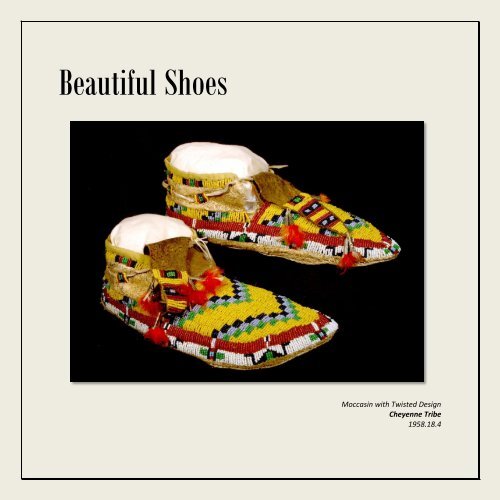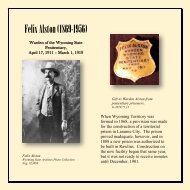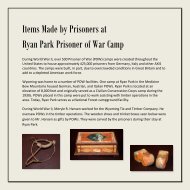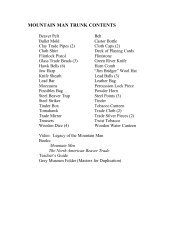Beautiful Shoes - the Wyoming State Museum
Beautiful Shoes - the Wyoming State Museum
Beautiful Shoes - the Wyoming State Museum
Create successful ePaper yourself
Turn your PDF publications into a flip-book with our unique Google optimized e-Paper software.
<strong>Beautiful</strong> <strong>Shoes</strong><br />
Moccasin with Twisted Design<br />
Cheyenne Tribe<br />
1958.18.4
Moccasins<br />
Functional, comfortable, and beautiful, <strong>the</strong> Native American moccasin is a truly useful piece of<br />
artwork. This exhibit provides a look at <strong>the</strong> form, function, and style of this unique piece of<br />
clothing.<br />
"Moccasin" was <strong>the</strong> first word English speakers heard to describe Native American footwear. It<br />
was soon used to describe <strong>the</strong> footwear of all tribes. Many differences existed in <strong>the</strong><br />
construction of moccasins as well as in <strong>the</strong>ir beadwork, quillwork, and color design. Some<br />
moccasins had soft soles, some had hard soles, o<strong>the</strong>rs had fur lining for added warmth. The<br />
following pages will examine some of those many differences.<br />
Front-Seam and Side-Seam Moccasins<br />
Front-seam moccasins have soft soles and <strong>the</strong> lea<strong>the</strong>r is folded so <strong>the</strong> seam runs up <strong>the</strong> center of <strong>the</strong><br />
foot. They were typical of <strong>the</strong> eastern border of <strong>the</strong> Plains and in <strong>the</strong> Ohio River Valley.<br />
Front-Seam Moccasin<br />
Ojibwa Tribe<br />
1921.1.29
Side-seam moccasins have soft soles and are made of one piece of lea<strong>the</strong>r folded and sewn on <strong>the</strong> outer<br />
side. This style of moccasin was often worn on <strong>the</strong> Nor<strong>the</strong>rn Plains.<br />
Side-Seam Moccasin<br />
Fla<strong>the</strong>ad Tribe<br />
1921.1.34
Hard Sole versus Soft Sole<br />
On <strong>the</strong> Plains, Native Americans wore two styles of moccasins, hard sole and soft sole. Hard<br />
sole moccasins began to appear in <strong>the</strong> mid-1800s. They were beneficial on <strong>the</strong> dry plains where<br />
cactus and thorns could pierce soft-soled moccasins.<br />
Originally, rawhide was sewn to <strong>the</strong> bottom of a soft sole to create a hard sole moccasin. Later,<br />
hard sole moccasins were made in two pieces.<br />
Soft Sole Moccasin<br />
Shoshone Tribe<br />
1966.88.24<br />
Hard Sole Moccasin<br />
Arapaho Tribe<br />
1958.18.13
Two-piece, hard-soled moccasins were made from a rawhide sole that was sewn to a lea<strong>the</strong>r upper. The<br />
two pieces were connected from <strong>the</strong> inside and <strong>the</strong>n turned out. Decoration was done before <strong>the</strong> two<br />
pieces were joined.<br />
Left - Two-Piece Moccasin Top Right - Two-Piece Softsole Moccasin<br />
Unknown Tribe Shoshone Tribe<br />
1962.31.68 1966.88.24<br />
The moccasin top on <strong>the</strong> left in <strong>the</strong> photograph above would have been sewn to a hard sole<br />
with a tongue cut behind <strong>the</strong> design. Its final shape would have looked like <strong>the</strong> moccasins on<br />
<strong>the</strong> right.
Parfleche Soles<br />
During <strong>the</strong> reservation period, old parfleche (rawhide) bags were recycled to make hard soles<br />
for moccasins. The sedentary life of <strong>the</strong> reservation did not require <strong>the</strong> travel bags that<br />
nomadic life did.<br />
Parfleche Bag<br />
Fla<strong>the</strong>ad Tribe<br />
1921.1.186<br />
Moccasin with Parfleche Sole<br />
Arapaho Tribe<br />
1969.166.2
Cuffs<br />
Cuffs were often added to moccasins. These cuffs could be turned up and tied around <strong>the</strong> ankle<br />
with a lea<strong>the</strong>r thong in bad wea<strong>the</strong>r.<br />
Moccasins with Cuffs<br />
Cheyenne Tribe<br />
1961.20.1
Right and Left<br />
Unlike early European shoes that were made exactly alike, most moccasins were specifically<br />
made for <strong>the</strong> right or left foot.<br />
Child's Moccasins<br />
Fla<strong>the</strong>ad Tribe<br />
1921.1.59<br />
Child's <strong>Shoes</strong><br />
1880 - 1890<br />
1959.31.6
Quillwork Decoration<br />
Quillwork used porcupine quills to create designs on lea<strong>the</strong>r. It was used for geometric designs<br />
because round shapes were hard to create. Quillwork was generally done by wrapping<br />
prepared quills around threads stitched to <strong>the</strong> piece being decorated.<br />
Drawings of Two-Thread, One Quill Sewing<br />
Drawing Credit: Barbara Hail, Hau, Kola!<br />
The Plains Indian Collection of <strong>the</strong> Haffenreffer <strong>Museum</strong> of Anthropology<br />
University of Washington Press, 1993<br />
Quillwork Detail<br />
Lakota Tribe<br />
1977.70.16
Red Quillwork<br />
Lines of red quillwork tend to be associated with women's moccasins and were largely made by<br />
<strong>the</strong> Dakota Sioux tribes in <strong>the</strong> late 1800s.<br />
Lines such as <strong>the</strong>se in ei<strong>the</strong>r quillwork or beadwork were often used to represent trails or paths.<br />
Moccasins with Red<br />
Quillwork Design<br />
Lakota Tribe<br />
1977.70.16
Bead Stitching<br />
Lazy Stitch<br />
The easiest way to bead large areas was to use <strong>the</strong> "Lazy" stitch. In <strong>the</strong> Central Plains, <strong>the</strong> Teton<br />
Dakota, Cheyenne, and Arapaho tribes used this style of beading. Eight to ten beads were<br />
strung to form a row that was sewn down at <strong>the</strong> ends.<br />
Drawing of Lazy Stitch<br />
Drawing Credit: Barbara Hail, Hau, Kola!<br />
The Plains Indian Collection of <strong>the</strong> Haffenreffer <strong>Museum</strong> of Anthropology<br />
University of Washington Press, 1993
Beads Applied with Lazy Stitch<br />
Lakota Tribe<br />
1973.44.59
Spot Stitch<br />
On <strong>the</strong> nor<strong>the</strong>rn plains, <strong>the</strong> Blackfoot, Assiniboin, Gros Ventre, and Plains Cree tribes<br />
used a beading style called “Spot” stitch. In this style, beads were threaded and laid<br />
in place for straight or curved lines. A second thread secured <strong>the</strong>m with a tiny stitch<br />
every one to three beads.<br />
Drawing of Spot Stitch<br />
Drawing Credit:<br />
Barbara Hail, Hau, Kola!<br />
The Plains Indian Collection of <strong>the</strong> Haffenreffer <strong>Museum</strong> of Anthropology<br />
University of Washington Press, 1993
Beads Applied with Spot Stitch<br />
Shoshone Tribe<br />
1966.88.24
Peyote Stitch<br />
In <strong>the</strong> South, <strong>the</strong> Comanche and Kiowa tribes used netted stitches called <strong>the</strong><br />
“Peyote” stitch. The Peyote stitch threads each bead to those at its diagonal corners.<br />
Drawing of Peyote Stitch<br />
Drawing Credit:<br />
Barbara Hail, Hau, Kola!<br />
The Plains Indian Collection of <strong>the</strong> Haffenreffer <strong>Museum</strong> of Anthropology<br />
University of Washington Press, 1993
Beads Applied with Peyote Stitch<br />
Rattle Beaded with<br />
Peyote Stitch<br />
Unknown Tribe<br />
1973.36.1
Bead Design Names<br />
Most bead designs have numerous names associated with <strong>the</strong>m. These names represent tribal,<br />
European, and individual differences. Some names are based on what <strong>the</strong> design looked like.<br />
O<strong>the</strong>r patterns were named after animal or plant shapes, but were not actually a<br />
representation of those things.<br />
The bead designs on <strong>the</strong> following pages may have additional names not listed in this exhibit
Cheyenne Design<br />
The Cheyenne tribe often used odd numbers of bead design patterns around <strong>the</strong> border of <strong>the</strong>ir<br />
moccasins so that one of <strong>the</strong> designs always fell on <strong>the</strong> toe.<br />
Moccasins with Cheyenne Design<br />
Lakota Tribe<br />
1921.1.29<br />
Detail of Moccasins with Cheyenne Design<br />
Lakota Tribe<br />
1921.1.29
Buffalo Tracks Design<br />
This long, curved, dark blue bead design is often referred to as “buffalo tracks” by non-Indians<br />
for its resemblance to <strong>the</strong> mark left by bison hooves. However, Native Americans called this<br />
pattern a “space” or “part-between” design.<br />
Detail of Moccasin with Buffalo Tracks Design<br />
Arapaho Tribe<br />
1967.18.1<br />
Moccasins with Buffalo Tracks Design<br />
Arapaho Tribe<br />
1967.18.1
Twisted Design<br />
Beads in diagonal checker rows, usually in three or more colors, are called “twisted.”<br />
Moccasins with Twisted Design<br />
Cheyenne Tribe<br />
1958.18.4<br />
Detail of Moccasin with Twisted Design<br />
Cheyenne Tribe<br />
1958.18.4
Fully-Beaded Moccasins<br />
In <strong>the</strong> early 1880s, women of <strong>the</strong> Teton, Assiniboin, and Cheyenne tribes, began to produce<br />
moccasins with fully beaded soles. While some people were buried in <strong>the</strong>m, <strong>the</strong>y were not<br />
specifically “burial moccasins.” Fully-beaded moccasins were a status item worn on special<br />
occasions by living people.<br />
The winged figure above represents <strong>the</strong> Thunder Bird. This sacred creature was thought to cause<br />
thunder and lightning.<br />
Fully Beaded Moccasin with<br />
Thunder Bird Design<br />
Cheyenne Tribe<br />
1973.81.06
Four Directions<br />
Crosses of various shapes were often used to represent <strong>the</strong> “Four Directions” which are still<br />
sacred to many Native Americans.<br />
Moccasins with Four Directions Design<br />
Arapaho Tribe<br />
1958.18.13
Triangles<br />
Triangle designs represent numerous things such as arrow points, vertebrae, and tipis. Triangles<br />
with a rectangle inside <strong>the</strong>m, such as those seen here, represent a tipi and its door.<br />
Moccasins with Triangle<br />
Tipi Design<br />
Lakota Tribe<br />
1973.44.59<br />
Detail of Moccasin with<br />
Triangle Tipi Design<br />
Lakota Tribe<br />
1973.44.59
Shoshone Design<br />
This bead design of a box with inverted triangles on ei<strong>the</strong>r side was commonly used in rawhide<br />
paintings of <strong>the</strong> Shoshone tribe. It was not unusual for painted designs to be copied into<br />
beadwork.<br />
Moccasin with<br />
Shoshone Design<br />
Lakota Tribe<br />
1921.1.29<br />
Detail of<br />
Moccasin with<br />
Shoshone Design<br />
Lakota Tribe<br />
1921.1.29
Tripe Design<br />
This bead design of rectangles and squares has been called <strong>the</strong> “Tripe” design.<br />
Moccasins with Tripe Design<br />
Arapaho Tribe<br />
1958.18.12<br />
Detail of Moccasin with Tripe Design<br />
Arapaho Tribe<br />
1958.18.12
Step Triangle Design<br />
This bead pattern is known as “Step Triangle.” It has also been called <strong>the</strong> “Mountain,” “Hill,” or<br />
“Cut-Out” design.<br />
Moccasins with Step Triangle Design<br />
Lakota Tribe<br />
1973.44.59<br />
Detail of Moccasin with Step<br />
Triangle Design<br />
Lakota Tribe<br />
1973.44.59
Fea<strong>the</strong>r Design<br />
Two-color, elongated diamond shapes are usually called <strong>the</strong> ”Fea<strong>the</strong>r,” “Whirlwind,” or “Breath<br />
of Life” design.<br />
Moccasins with Fea<strong>the</strong>r Design<br />
Arapaho Tribe<br />
1987.33.3<br />
Detail of Moccasin with Fea<strong>the</strong>r Design<br />
Arapaho Tribe<br />
1987.33.3
Box Design<br />
Box designs of squares were often meant to represent bags.<br />
Moccasins with Box Design<br />
Crow Tribe<br />
1921.1.30<br />
Detail of Moccasin with Box Design<br />
Crow Tribe<br />
1921.1.30
Floral Designs<br />
Floral designs are often associated with tribes from <strong>the</strong> eastern United <strong>State</strong>s. However, floral<br />
patterns can be found in most regions. Floral beadwork is usually created using <strong>the</strong> spot stitch<br />
technique. The Shoshone tribe of <strong>Wyoming</strong> is famous for what is known as <strong>the</strong> “Shoshone<br />
Rose” design.<br />
Shoshone Rose Design<br />
1961.46.1
Problems in Tribal Identification of Moccasins<br />
With so many design differences, why is it difficult to identify moccasins with a specific tribe?<br />
Inter-tribal marriage, trade, and outside influences led to a blending of moccasin and beadwork<br />
styles. The moccasin below has a Shoshone tribal design, a Cheyenne tribal design, and was said<br />
by <strong>the</strong> donor to be from <strong>the</strong> Lakota tribe.<br />
Lakota Tribe<br />
1921.1.29
Contemporary Moccasins<br />
Moccasins continue to be made by numerous artisans. While many follow traditional patterns,<br />
o<strong>the</strong>rs incorporate modern or exotic materials creating contemporary works of art. Both styles<br />
continue <strong>the</strong> long-standing Native American tradition of creating beautiful shoes.<br />
Artist: Jody Comes<br />
Pine Ridge, South Dakota<br />
photo: Nebraska <strong>State</strong> Historical Society<br />
10921-30-(1-2)<br />
Artist: Cleo Goggles<br />
E<strong>the</strong>te, <strong>Wyoming</strong>






